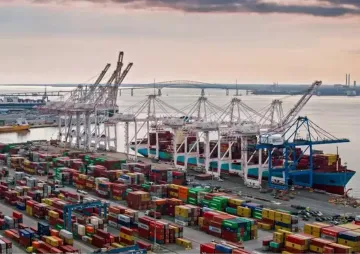
“Why do you think only white people support Trump?”
That was in reaction to our earlier story — “Are there enough angry white voters to fuel a Trump presidency?”
Trump voters are predominantly white, lack college education, and mourn their exclusion in a rapidly changing America — the other extreme of the opulence you see in this picture above and they’re an unprecedented disruptive force in the 2016 election.

Hours after Islamic suicide bombers struck in Brussels killing 35 people, Donald Trump, a real estate magnate turned US Presidential frontrunner, did a whirlwind tour of the morning news circuit in America, working the tumult with another war cry to ban all Muslims.
“This madness must be stopped. I will stop it,” he wrote on his 24 hour bullhorn — Twitter, and got 14,000 retweets. He is now up to seven million plus follows.
Republican voters may vary on whether Trump can govern in a crisis, but for his ‘ban all Muslims’ bluster, they are giving him a carte blanche.


Trump’s Twitter account is rising by 50,000 every day, which critics dismiss as dangerous flummery.
Intuitively, Trump’s real audience is much bigger than the numbers of his Facebook and Twitter handle followers because of the thousands of retweets.
That doesn’t mean everyone agrees. Comments to Trump tweets range from slapstick — “Brussels is still beautiful and you’re still an idiot” — to lewd comments about his wife’s GQ shoot.
Even the number of retweets must be discounted for false online personas and the inherently polarising nature of social media, but the fact is that Trump’s numbers and poll performance have rocketed after the Paris attacks on November 2015 and the San Bernardino shooting in December 2015.
One “global risk” Trump has mastered the other — social media — and together, they’re fueling anti-immigration populism in America that is translating into votes in the primaries, something that Trump sceptics thought was plain delusion barely six months ago.
Trump keeps saying he has brought millions of new voters into the race for the Republican Party — a large part of which loathes him, but won’t say it. On the other side, Hillary Clinton has put the best data brains who worked for Obama’s re-election into her 2016 bid.
Trump has the most money and spent the least on acquiring voters — his “burn rate” is the lowest among all candidates. The Economist data chart below shows how Trump has been less dependent on raising money, relying instead on his mammoth advantage in free and feral media.
< style="color: #0180b3;">Although Donald Trump has mastered Twitter, the world’s largest social network Facebook will enjoy tremendous clout in the 2016 US presidential election.
Its powerful data mining tools allow campaign strategists to target voter groups by the television shows they watch and so use TV ads better, help plan timing of ads and messages based on when people are online.
Trump’s messaging is built for social stickiness — simple, unexpected, emotional, swift.
Plot all these on a Google trend graph and see what you get — you can play with the variables. Below is a mix of Trump, Paris Attacks, San Bernardino and Hillary Clinton.
Trump’s is the blue line, Hillary is the green line, the two terror attacks are the red and yellow.

This oddity is that those voting Trump are the non-Trumps — old economy folks from agriculture, construction, trade or manufacturing or unemployed — the masses who feel they’ve fallen behind and are hoping the economic balance will tip back in their favour.
The demographic that routinely scores highest for Trump is those whose formal education ended with high school, reports AFP.
Piers Morgan on Donald Trump: “I didn’t feel I was talking to a lunatic.”
Twitter trends on #Brussels attacks day
On the day of the Brussels attacks, #DonaldTrump trended in six countries and 15 cities reaching a top trend position at #3 in places as faraway from the US primaries as Austria and Singapore.
The simpler #Trump trended in three countries and 27 cities, acquiring top position at #1 in seven locations.
On the same day, Twitter users in 26 countries devoted themselves to #Brussels attacks which ruled as the #1 hashtag across 137 locations in 192 cities.
#Muslims trended in 22 countries and 115 cities, top trend in five locations.
On the same day, #Clinton, #HillaryClinton, #Hillary, none of these turned in trend results on Twitter, but was trending on Facebook.
Clearly, social networks will be played aggressively in the world’s costliest election, but how much of a difference will it make to the result?
Two to three percent in a tight race, estimates The Economist, that’s potentially match winning if you consider the net add-ons in America’s voter base: 10.7 million new eligible voters in 2016.
Playing on emotion in social media messaging
• Paris Attacks on November 2015
• San Bernardino shootings on December 2015
• Brussels attacks on March 2016
How many of you who’ve travelled to Brussels or Paris get goosebumps looking at the ghost-town images after a suicide bombing at the airport check in counter, bloodshed at a cafe, glad it wasn’t someone dear? How do you react to the word “diplomacy” after what you know about Salah Abdeslam and the California shooters?
Donald Trump has played on the fear and anger every traveller feels, most of his messages come straight out of a smartphone without going through foreign policy filters unlike the other candidates.
Donald Trump is a frontrunner today but he wasn’t that way before November 2015.
In the two months before Paris, Trump’s national polls had stagnated in comparison with a famous doctor from Johns Hopkins, Ben Carson, who was pulling ahead in key states. Google search interest in Trump was also flagging. Today, Carson is out of the race, Trump is way ahead of the pack.

The Paris and San Bernardino attacks gave Trump’s numbers an uptick — from 28 percent before Paris to 35 percent by mid December — after the San Bernardino attacks, says Nate Silver of Five Thirty Eight.
The San Bernardino shooters killed 14 people on Dec 1, 2015. On December 6, Trump called for banning all Muslims and Google search for Trump more than doubled instantly.
< style="color: #0180b3;">With three terror attacks in the last six months between Europe and America, Trump will only escalate his attacks on Muslims and immigrants in the coming days. Until now, the two were separate issues, now it’s all the same as far as Trump is concerned — Muslim immigration = terror.
Trump after Brussels
“I think this whole thing will get worse as time goes by,” he said. “It’s being, you know, perpetrated all over the place now. Brussels is in very bad shape, but many cities will be this way with what’s taking place, and it’s really the policies of people who don’t know what they’re doing.”
Trump on Abdeslam
“There is something wrong, and we have to get to the bottom of it, when someone like who was just captured was really coddled and taken care of by people that live in the neighbourhood.”
“Many people knew he was there, yet he was the No. 1 fugitive in the world. Everybody from that area knew he was there and nobody turned him in.”
“I have great respect for Muslims, I have many friends that are Muslims. I am just saying there is something with a radicalised portion that is very, very bad and very dangerous.”
Trump on ISIS
“I would hit Isis so hard you wouldn’t believe it and I would get the people over there to put up their soldiers because it’s about time that somebody did it.”
“But I would have such backup like you’ve never seen before in terms of air power, air strikes, etc.”
< style="color: #0180b3;">Trump is not the first man to propose a “big beautiful wall” along the country’s border to keep “rapists” out.
Others have done it with xenophobic enthusiasm and profited.
In the summer of 2015, Hungarian Prime Minister Viktor Orban built a fence to keep migrants out as part of his radical anti-immigrant policy. His popularity has never soared this high in the last six years.
Chaotic scenes of migrants pouring in at the border have helped politicians in Europe who are anti-immigration.
Except for Sweden, anti-immigrant parties are topping the polls in Netherlands, Denmark and Hungary.
< style="color: #0180b3;">America is not the first country witnessing a polarising election agenda although it’s the only one where $5 billion is being spent on the circus.
Country after country, the fringe is raking in the spoils after centrist unifiers tried to please too many and lost people’s faith.
Social networks, politicians and democracy

Just as voter turnout in the primaries is not a reflection of total eligible voters or general election turnout (50 percent of Americans stay home on voting day), social networks too frequently get flak for the rash of polarising opinion which may not represent common sense.
Whether social networks, databases and the dynamics of these networks will change the outcome of an election may not be even relevant — embracing social networks is an unavoidable choice because it is giving all candidates the ability to test ads and change messaging on the go, keep costs down, and know everything about everybody who might vote.
< style="color: #0180b3;">Today, if you go to the Hillary Clinton website, there are 12 job openings in her campaign that are all “Digital” something — which call for all levels of digital and social media proficiency from analysing metrics to creating zippy videos.
Hillary Clinton is likely to raise at least half of the $5 billion likely to be spent on the election this year — and has all the money to hire technical talent, pay for polls and buy advertising on Facebook.
With more powerful targeting, it is possible to pinpoint individual voters on Facebook and not just groups — all at a fraction of the cost of traditional media.
Dan Wagner led Obama’s data team for his second bid in 2012. In what was to become a major news feature in the world’s top magazines later, they did the simple A/B tests that are now taught in social media courses at the world’s top universities.
For example: How much could “Bernie is outspending us” bring in for Hillary versus “Love trumps hate.”
Although Obama’s second term campaign is the more common example to equate how digital force is powering the 2016 US Election, where it started as a political tool of some consequence is the Arab Spring in 2011.
An anonymous Facebook page was the beginning of the end for the Hosni Mobarak government.
Soon enough, the coalition that toppled the government also lay tattered.
At the cusp of social media and politics, better democracy is not a given, cheaper campaigns certainly are.
Meanwhile, even as Muslims keep coming in to the US, they’re coming into a country where more voters (with smartphones) don’t want them.
The author is Senior Editor at Firstpost, and is based in New York. Follow her on Twitter: @byniknat
Data, charts and image, courtesy, Pew, Five Thirty Eight, The Economist, Google Trends and Reuters.
The views expressed above belong to the author(s). ORF research and analyses now available on Telegram! Click here to access our curated content — blogs, longforms and interviews.








 PREV
PREV

